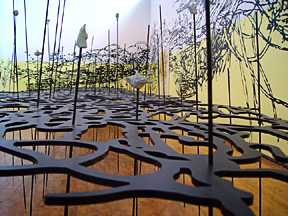This season at the Massachusetts Museum of Contemporary Art, a large-scale exhibition of the work of Matthew Ritchie is an astounding accomplishment of mental power, organization, and breadth. The exhibition is comprised of canvas paintings, wall and floor paintings, window paintings, sculpture, installations, digital projections, a digital craps table, drawings, short stories, and sound based work. Ritchie’s work can be misleading- it is so pleasing to look at formally, one can easily overlook the conceptual framework that is the greatness of his art. It is enjoyable on a purely visual level, but even more rewarding if you do some homework.
The origin of the work in this exhibition started in 1995, when Ritchie made a systematic list of 49 characteristics, attributes, forces, colors, shapes, and elements from which to work from. Called The Working Model, this list has been the conceptual root of all his work since. For Proposition Player, this list has been modified into a deck of cards, each with a pixilated pictograph of the character. Each character’s name and attributes are printed on the card along with a number and suit in typical playing card fashion. At the entrance of the exhibition you are given one of these cards. It is your ticket for the digital craps table and your unmitigated involvement as a participant in the game and universe that Ritchie has brought to MassMoCA.
The paintings in the exhibition belong to a series that Ritchie calls The Main Sequence. The subject of this series is the saga of the universe and its modification through time. At some point in this saga, human life develops and becomes a central theme in the work. Ritchie weaves the figures into the images in such a way as to fuse them with his depicted universe. The implication is the universe within mirrors or partakes of the universe without. In other words, we as humans are playing out the history of the universe. This theme is reiterated by the assigning of each visitor (via the card they are given) an essential force necessary for the creation of the universe. The craps table is a game where one must continue to roll the dice until all the elements necessary to create the world are acquired. At each roll, the accompanied force and color field or shape corresponding to the dice is added to the digital display. These shapes mimic those of the paintings. Because each player will roll a different sequence via the dice, his or her relationship to the structure and building of the universe is unique.
In the same way that Ritchie has a solid underlying conceptual framework to his art that may not be apparent at first view, he also has a very systematic formal vocabulary of color, marks, and gestures in his paintings. He has a mind bent toward classifications and organization. Because of this, he can depict spaces that are immensely layered and complex with clarity, playfulness, and grace. His catalogue of gestures and tendencies include polychrome eyeball shapes that look like the stickers of eyes that come with kite packages, flat taped-off hard-edged planes and gross lines of solid color, transparent hand-painted organic shaped swirls, tendrils, and bubbles that are loosely modeled, and marker-made diagrammatic lettered circles and ellipses that connect with each other by straight or curved lines and arrows that recall flowcharts or scientific illustrations.
Ritchie is an accomplished colorist, but conceptually driven. Ritchie’s hue choices and close attention to intervals of value create convincing color worlds of space and dimension. His interest in painting that functions both aesthetically in a modernist sense and communicates as a language that can be read and openly interpreted has led him to use color as a means to both. The simplification and flatness of fields of color allow the legibility of the symbols and text in the paintings while simultaneously providing a level of ambiguity by lack of detail to be inclusive of interpretations of the forms as molecular, symbolic, depictive, or aesthetic.
As objects, the canvas paintings stand out as the showpieces of the exhibition. They are incorporated with the rest of the show to some degree but stand out as autonomous. Because of Ritchie’s experience as a painter and his excellent color sense, one is drawn into the paintings as to large planets exercising their gravitational pull. The rest of the objects in Proposition Player feel like a player piano, where you can still thoroughly enjoy the tune, but miss the nuances.
Conceptually, this ties in with another theme of Ritchie’s work, the limits and effectiveness of systems of knowledge. He states: “We can only see 5% of the universe…We’re working from a model with 95% of the information missing. So the big question for me is how do you visually represent that absence?” In The Fine Constant, Ritchie asked kids from New York and Houston to construct sculptural representations of the characters from the deck of cards. These sculptures were scanned into a computer and presented through polygons. 95% of the information was subtracted. The sculptures were then manufactured from the remaining information and placed at the top of the spear-like poles that support the bulk of The Fine Constant. Even with 95% of the information gone, there is a strong semblance of the original. Ritchie is making a point here. His seemingly absurd desire to understand and represent the universe in this context comes off as profoundly moving and perhaps a little less absurd. It’s not that I believe Ritchie’s paintings are accurate representations of the universe, but that there is a semblance of the connections or order he tries to make between the onslaught of endless information. His system is not scientific, but it still becomes a means to organizing and linking diverse histories, mythologies, desires, and images. It is a heroic undertaking that doesn’t manifest itself in any particular work of Ritchie’s, but in its underlying quest to make sense of all aspects of the world around us.
Links:
Massachusetts Museum of Contemporary Art
"Matthew Ritchie: Proposition Player" is on view until Spring 2005 at MassMoCA, 87 Marshall St. North Adams, MA
All images are courtesy of Matthew Ritchie and MassMoCA.
Nathan Lewis is a New Haven based painter and educator and founder of the group ICAANDI (Intelligent Contemporary Art And Narrative Driven Imagery). Nathan is a regular contributor to Big, Red & Shiny.




